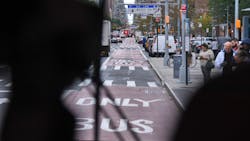New bus-mounted cameras catch more than 1,500 vehicles in M15 SBS bus lanes since enforcement began Oct. 7
More than 1,500 vehicles have been captured blocking bus lanes on the M15 Select Bus Service route since bus-mounted camera enforcement began Oct. 7, according to the Metropolitan Transportation Authority (MTA) New York City Transit (NYC Transit).
“We are very serious about keeping bus lanes clear because transit priority is part of our path to faster, more reliable buses under the Fast Forward plan to improve service,” said MTA NYC Transit President Andy Byford. “For the first time, we are able to help the city enforce them, and this shows how serious we are about safely speeding up service for our bus riders.”
“So far, the program shows that vehicles are often in bus lanes, blocking or slowing buses that affect M15 SBS service,” said Craig Cipriano, Acting MTA Bus Company president and senior vice president for Buses of NYC Transit. “Our new bus-mounted cameras and the combined enforcement efforts of NYCDOT and the NYPD are powerful new tools that build upon the success of Select Bus Service and make it even more effective.”
NYC Transit is using an Automated Bus Lane Enforcement (ABLE) system on 51 buses that travel on the M15 Select Bus Service route, which uses dedicated bus lanes implemented by the New York City Department of Transportation (NYCDOT). ABLE camera systems capture evidence such as license plate information, photos and videos, as well location and timestamp information, of vehicles obstructing bus lanes to document clear cases of bus lane violations. The system collects multiple pieces of evidence from multiples buses traveling in the bus lanes to ensure that vehicles making permitted turns from bus lanes are not ticketed. The package of evidence is transmitted to NYCDOT for review and processing, and the program is administered in partnership with NYCDOT and the NYC Department of Finance.
“Under Mayor de Blasio’s Better Buses Action Plan, we have committed to increase citywide bus speeds 25 percent by the end of 2020 – and to get there, we will need to step up enforcement to keep vehicles out of the more than 100 miles of dedicated bus lanes we have built around the city,” said NYCDOT Commissioner Polly Trottenberg. “For years, we had overhead cameras along routes like the M15, but adding enforcement cameras to the buses themselves will help us further keep bus lanes clear – allowing tens of thousands of commuters to keep moving.”
Motorists who remain in a bus lane for five minutes or longer, or who are captured as blocking the bus lane by two successive buses, are considered violating traffic laws and will be ticketed as such. Since implementation started on Oct. 7, the bus-mounted cameras captured 1,529 vehicles blocking bus lanes on the M15 SBS route. During the initial 60-day grace period, motorists who block bus lanes are issued a warning that does not carry a fine. After the first 60 days of implementation, motorists who continue to block bus lanes will be subject to a fine of $50 for the first violation, and for additional violations within a 12-month period: $100 for a second offense, $150 for a third offense, $200 for a fourth offense and $250 for a fifth violation and each subsequent offense thereafter within a 12-month period.
The MTA’s bus-mounted camera enforcement program will expand to the B44 SBS and M14 SBS by the end of November, with the ABLE system to be deployed on a total of 123 buses across the three routes. The proposed 2020-2024 Capital Plan includes $85 million for further expansion of the program.
NYC Transit is working with NYCDOT and New York City Police Department (NYPD) to increase bus lane enforcement in highly congested areas as part of NYC Transit’s Fast Forward plan to improve bus service, increase bus speeds and attract new ridership. MTA’s bus-mounted cameras are working in parallel with NYCDOT’s stationary cameras on streets, and NYPD’s initiatives to deter parking in bus lanes, which began earlier this year. Results so far have yielded faster bus speeds by as much as 19 percent on a portion of Fifth Avenue and as much as 30 percent near the Hugh L. Carey Tunnel’s Manhattan approach. Other strategies include redesigning every borough’s bus network to better meet customer needs, installing traffic signal priority technology, implementing more transit priority str



